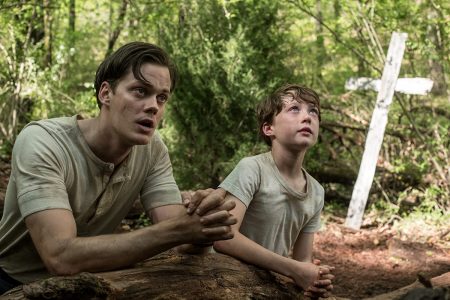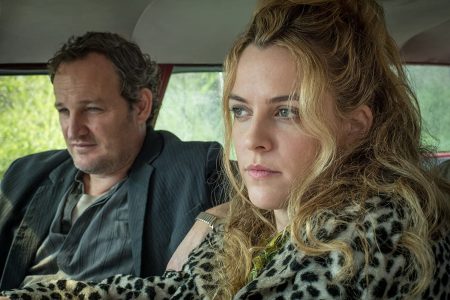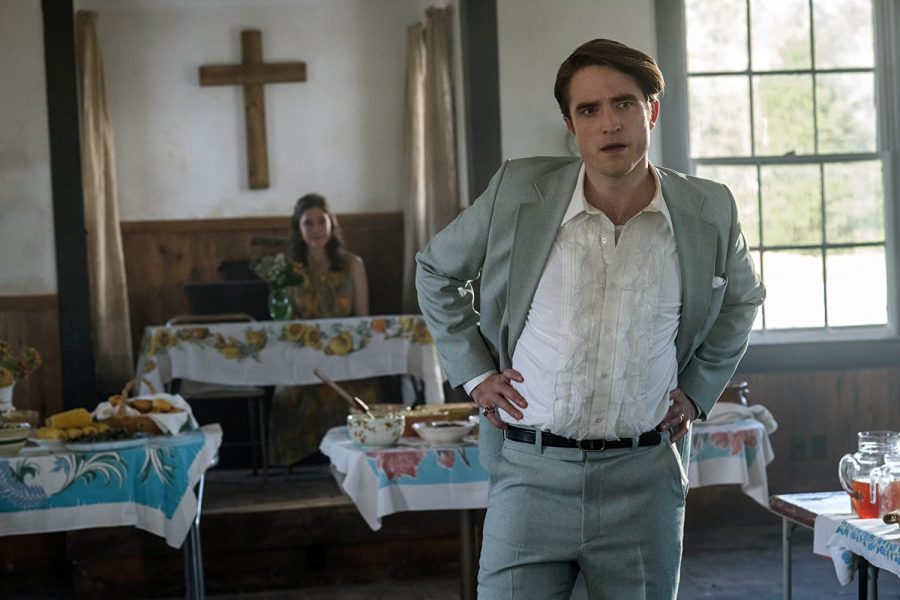REVIEW: ‘The Devil All the Time’ serves gore, wickedness, but lacks depth
Book-to-film adaptation has star-studded cast including Tom Holland, Bill Skarsgård
Robert Pattinson and Lucy Faust as Preston and Cynthia Teagardin in Netflix’s book-to-film adaptation of “The Devil All The Time.” Photo courtesy of Netflix, Inc.
September 22, 2020
What would we have done with ourselves if Robert Pattinson wasn’t giving us new performances to watch during this pandemic? Talk about range.
“The Devil All The Time,” directed by Antonio Campos, premiered earlier this week on Netflix. The Southern Gothic film is based on the novel of the same name by Donald Ray Pollock. I’m personally always in excited anticipation of any book-to-film adaptations and can’t help but attempt to read the novels before seeing the movies.
Story continues below video.
The R-rated film managed to novelize the story in a way that kept the spirit of the book central to the film while also taking a more visually aesthetic approach.
Set during a time after the second World War, the movie takes place in what is meant to be 1950s rural Ohio and West Virginia.
This psychological thriller follows an ensemble of overzealous religious people who all have a unique and sometimes fervent interpretation of what’s good and what’s evil. The lives of a crooked sheriff played by Sebastian Stan, a murderous couple played by Riley Keough and Jason Clarke, a flamboyant preacher played by Robert Pattinson, and a traumatized war veteran played by Bill Skarsgård all weave together in connection to Tom Holland’s character, Arvin Russell.

In a series of character introductions, time jumps and flashes forward, the movie eventually circles back and centers on Arvin, his trauma and the issues he faces as a result of his childhood.
“The Devil All The Time” is certainly not for the faint of heart.
Campos attempts to tell a multi-generational tale of tragedy and sin through a messy narrative that ultimately fails in making a point, leaving the ending inauspicious.
Campos wrote the screenplay with his brother, Paulo Campos. Campos’ most recent feature film was “Christine,” a biographical film in 2016 about a reporter who died by suicide on live television. He is well-known for his edgy content.
Although all the action, blood, violence and gore in the film remain from the book, there is no rewarding exposition for the audience to receive after two hours of suffering.
The period drama was filmed on a 35mm camera, which is a reason in itself to view the movie. The grain of the picture adds detail and makes for a vivid viewing experience.
Even when the movie began to slow in certain acts, the slate of charismatic performances were enthralling to watch. Countryside roads, green forestry and sodden wooden shacks create a fitting landscape for “The Devil All The Time” to come alive. Saunder Jurriaans’ and Danny Bensi’s musical score adds another layer of eeriness, as daunting and ominous ballads play in the background during more tense, confrontational moments.
A mix of still and tracking shots help in emphasizing the gravity of some scenes. For example, a camera follows a guest speaker up the aisle in the scene where he speaks during a church service and as he turns, the camera turns 360 degrees to capture the church audience’s reaction which creates a cool, intimate effect. On occasion, the author’s voice itself is heard in the film’s narration whenever a character is facing an internal conflict.
Sometimes the narration effectively worked, sometimes it felt overbearing.
By utilizing different angles and even light and color, Campos does a fantastic job using visual cues to express the emotional turmoil the characters are experiencing. Shallow depth of field is well done in quiet, yet pivotal scenes where viewers can also see the sunset against the pastoral background.
The characters are strategically framed in a way to convey emotion. For instance, some of the most significant moments for characters are faceless. With their backs exposed to the camera, their vulnerability is intentionally put on full display.

Bill Skarsgård gives a great performance that carries the entire first act of the film. His ability to transition from a smitten family man to a haunted war veteran overcome by grief and rage sets the tone for the rest of the film.
Robert Pattinson also stands out as a corrupted preacher. Pattinson’s and Skarsgård’s characters have a rustic and menacing demeanor that they visibly embody in body language and dialect. Despite the amount of British, Swedish and Australian actors attached to this project, their Southern accents remain forgotten after hearing Pattinson’s exuberant voice.
Sandy is portrayed by Riley Keough, who has always outdone herself with as much screen time she’s given. Her character is one half of a pair who picks up male hitchhikers in order to deviously toy with them. She’s a scene stealer — all attention falls on her, especially in Sandy’s worst moments.
Degradation of women is a theme in both the film and the novel. Harming women and reducing them to sexual objects is a trait well overplayed and presents nothing new that already hasn’t been done before. Frankly, it’s boring and overrated to continue to have women act as sources for “manpain.”
It’s almost inevitable to say that the book is always better than the film. This grim, gothic tale is told in a way that films by an all-white cast often are: not everyone can resonate with it, but it’s perfect to stream when there’s nothing else.

























































































































